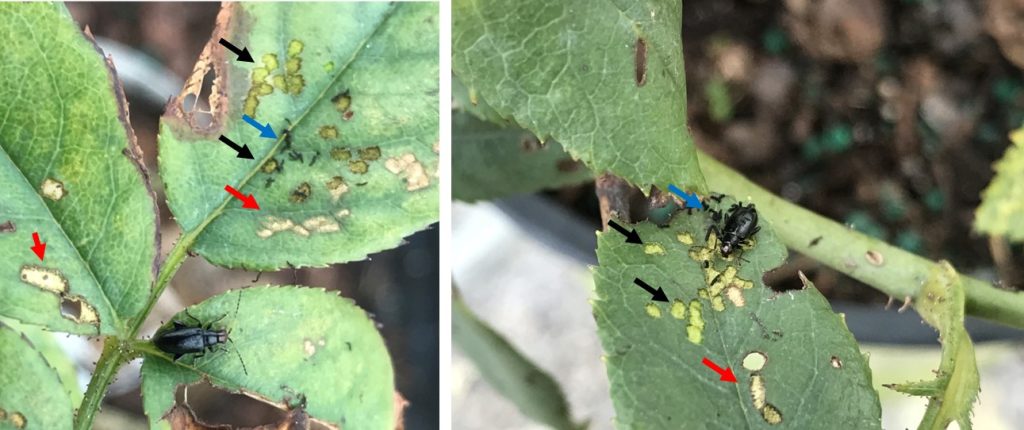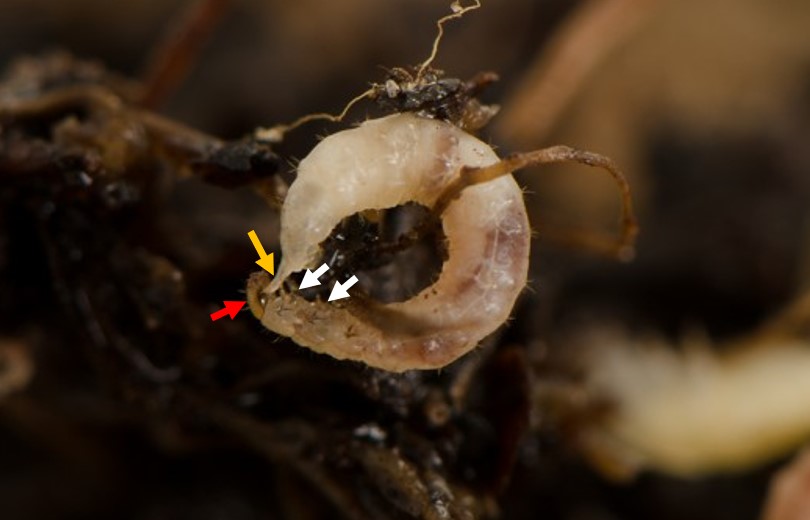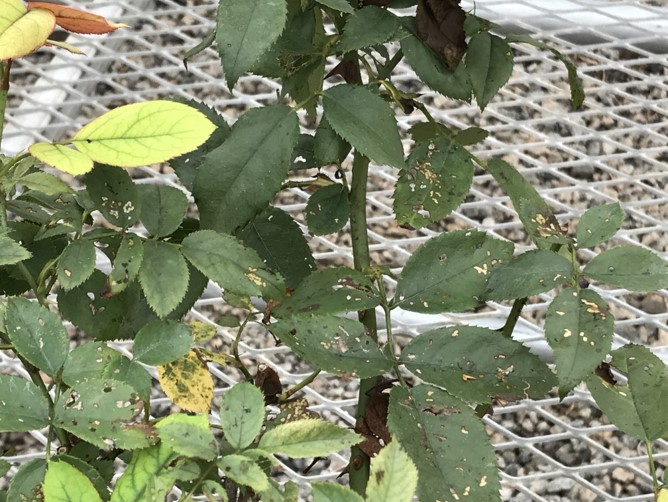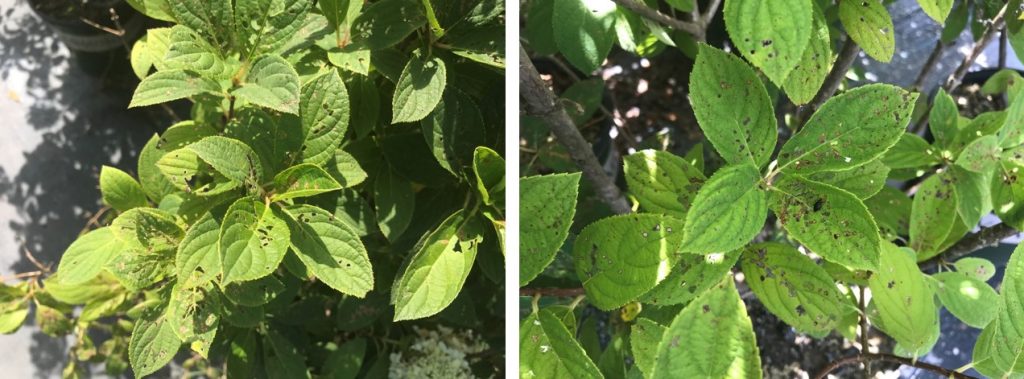The redheaded flea beetle (RHFB), Systena frontalis (F.) (Coleoptera: Chrysomelidae) (Fig. 1) is a serious insect pest in ornamental nurseries. It is also referred to as cranberry flea beetle in cranberry and blueberry systems in the northern US. The adult RHFB causes serious feeding damage to the foliage of a variety of woody and herbaceous container plants in nurseries (Figs. 3 and 4). As the name suggests, RHFB jumps when disturbed, similar to a dog flea. RHFB is native to the US and is present in the central and eastern US.

Identification and Biology
RHFB adults are small, shiny, oval shaped beetles, about 0.2 inches in length, with metallic-black colored bodies and the red-colored head which is a unique identifying character that distinguishes these beetles from other similar species. Females are slightly larger than males. A pair of light-brown serrate antennae originates below the eyes, with dark-brown distal segments. On the last pair of legs, the femur is wider and swollen which enables RHFBs to jump.
Mature females lay pale-yellow eggs singly in the potting medium. Larvae are about 0.5 to 1 cm in length and are creamy-white in color (Fig. 2), with the head capsule and 3 pairs of legs pale-brown in color. The last segment on rear end of the larva is oriented upward with prominent setae (hairs) (Fig. 2). They undergo three larval stages which all feed on roots.
RHFB overwinters as eggs. In nurseries, adult beetles are first observed feeding on foliage typically during last week of May in most of Georgia, although this could be subject to local weather conditions. After a distinct first generation emergence in the spring, multiple overlapping generations occur in Georgia until late October. During summer, multiple stages (eggs, larvae, and adults) may be found on an individual containerized plant.

Host Plants
RHFB feed and cause damage to numerous plants grown in the nursery industry. In Georgia, high numbers of RHFB have been found on hydrangeas [panicle hydrangea (Hydrangea paniculata)] and roses (Rosa sp.). In addition, RHFB damage has been reported on Virginia sweetspire (Itea virginica), forsythia (Forsythia x intermedia), anise-tree (Illicium spp.), azalea (Rhododendron spp.), crapemyrtle (Lagerstroemia spp.), dogwoods (Cornus spp.), Japanese holly (Ilex crenata), weigela (Weigela florida), loropetalum (Loropetalum sinense), fragrant osmanthus (Osmanthus fragrans), viburnum (Viburnum spp.), wax myrtle (Morelia cerifera). They also attack Vacinium spp. (cranberry & blueberry) specifically, lowbush blueberry (Vaccinium angustifolium) cranberry, (Vaccinium macrocarpon), and highbush blueberry (Vaccinium corymbosum) as well as alfalfa (Medicago sativa) in the northern states. In addition to woody plants, RHFB attacks herbaceous hosts such as aster (Aster spp.), chrysanthemum (Dendranthema spp.), tickseed (Coreopsis spp.), goldenrod (Solidago spp.), joe-pye weed (Eupatorium spp.), salvia (Salvia spp.), sedum (Sedum spp.), veronica (Veronica spp.), and zinnia (Zinnia spp.).
RHFB also attacks weeds such as jewelweed (Impatiens capensis), lambsquarter (Chenopodium album), pigweed (Amaranthus spp.), smartweed (Polygonum spp.), Canadian thistle (Cirsium arvense), clover (Trifolium spp.) and common burdock (Arctium minus). The range of plants reported as damaged by RHFB suggests that the beetle can feed on virtually any broad-leaved woody or herbaceous plant growing in or around the nursery.

Damage Symptom
RHFB adults feed on the leaves causing numerous holes, or sometimes skeletonize by removing the surface layer of both upper and lower sides of mature leaves (Figs. 3 and 4). They often deposit fecal matter near the feeding site (Fig. 1). Damage to plants can be severe and rapid depending on the number of invading RHFB adults. Affected plants are typically not marketable. Although RHFB larvae feed on the roots, they rarely cause noticeable damage.

Monitoring and Management
Nursery plants, especially those preferred hosts, should be aggressively scouted weekly for adult activity starting in mid-May preferably during mid-day. Because RHFBs attack volunteer species, weeds also should be scouted. As part of cultural control, removing weeds in and around the nursery could reduce food resources for adult RHFB and prevent population build up in the general area. If the container stock is already infested with RHFB, it is advised not to place newly propagated plant containers near infested stock plants.
As biorational options, microbial biological control agents such as the entomopathogenic nematode (Steinernema carpocapsae) as well as entomopathogenic fungi (Beauveria bassiana and Metarhizium anisophliae) are effective on larval stages of RHFB in containers.
Foliar applications of insecticides are essential to manage adult populations. Depending on the number of invading RHFB adults on plants, multiple applications might be warranted to bring the population under control. There is no threshold determined for this pest as the market is driven by zero damaged plants. Adult RHFB are highly mobile; thus, coverage is important especially when contact insecticides are used for control. For current insecticide recommendations, contact your local county Extension office.
Soil drench application of insecticides in the container can yield acceptable control of larvae if uniform distribution of the insecticide throughout the root ball can be ensured. Soil drench can be applied as preventative treatment in spring if the plants were exposed to adults in the previous season. RHFB larvae can develop within small volume of non-treated soil medium in the container. Even though high larval densities may be present in the soil, it is not certain that all of the adults feeding on the foliage originate from the same container. Therefore, regular scouting and removal of weeds could help reduce the insect load on the desirable nursery stock.
References
Ahola, K. L., D. C. Weber, and S. R. Roskelley. 2000. Control of flea beetle in cranberry with thiamethoxam, 1999. Arthr. Manage. Tests, 25 C8, https://doi-org.eres.qnl.qa/10.1093/amt/25.1.C8
Averill A. L. and M. M. Sylvia. 2011. Red-headed flea beetle, Systena frontalis (F.) (Coleoptera: Chrysomelidae). 2011. University of Massachusetts Cranberry Experiment Station. https://ag.umass.edu/sites/ag.umass.edu/files/fact-sheets/pdf/red-headed_flea_beetle.pdf
Cloyd R. A. and N. J. Herrick. 2018. Red headed flea beetle. Kansas State University Agricultural Experiment Station and Cooperative Extension Service. MF3225. https://www.bookstore.ksre.ksu.edu/pubs/MF3225.pdf
Mahr, D. L. 2005. Red headed flea beetle. Wisconsin Cranberry Crop Library. Insect profiles. http://www.hort.wisc.edu/cran/
Dittl, T. 1988. A survey of insects found on cranberry in Wisconsin. M.S. Thesis, University of Wisconsin, Madison.
Maltais, P. M., and M. C. Ouellette. 2000. A note on Systena frontalis [Coleoptera: Chrysomelidae] adults on lowbush blueberry, Vaccinium angustifolium. Phytoprotec. 81: 129-131.
Peters, D. C, and H. E. Barton. 1969. Systena frontalis larvae in corn roots. J. Econ. Entomol. 62: 1232-1233.
Richard L. Jacques, Jr., and D. C. Peters. 1971. Biology of Systena frontalis with Special Reference to Corn. J. Econ. Entomol. 64: 135–138.
Storch, R. H., F. E. Manzer, G. I. I. Sewell, and O. P. Smith. 1979. Adult red-headed flea beetle found feeding on potato in Maine (Coleoptera: Chrysomelidae). Am. Potato J. 56: 363-364.